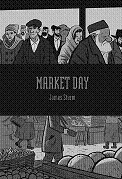
Market Day
James Sturm
Drawn and Quarterly
$23.95
cloth
96pp
978-1-897299975
The industrial revolution, which values plentiful goods at a cheap price over fine craftsmanship, has begun, and when Mendleman loses the one person who valued the quality of his rugs, he is thrust into an unwelcoming marketplace. Unprepared for such a change, he starts to sink deep into despair as his livelihood slips away, making him reconsider his vocation. After selling his goods for a fraction of their former value, he dejectedly starts the journey home and thinks: “Tomorrow I sell my loom.”
Sturm – an Eisner-award-winning graphic novelist well known for his historical fiction, such as The Revival and The Golem’s Mighty Swing, and for his superhero series Unstable Molecules – has crafted a story of heartbreak and misfortune out of an all too common situation. Unfortunately, Mendleman has difficulty negotiating the world around him, except through his rugs: “Even when my mother died. It wasn’t sitting Shiva that comforted me. It was sitting at my loom making a rug.” Abandoning his work means letting go of the one thing that allows him to cope.
The panels are illustrated in a simple and minimalist fashion. There are big spreads that look sparse and the human figures don’t have many distinguishing features. The plain compositions give the pastoral settings a very open and airy look. Neither the art nor the narrative has to battle for prominence and the syncopation they achieve at certain points is very moving.
This austere style also accentuates Mendleman’s mood. When he perceives the marketplace as an exciting and invigorating place, we see children playing and the abundance of goods. But when the market turns on him, the panels are filled with the ugly wretches and pitiless people who are also present. The stark drawings pull in the readers’ focus so that they can share in the nuanced emotions of the protagonist. It allows readers to see how the narrative he articulates to himself compares with the things he envisions. What people are willing to commit to words doesn’t always fully express what they actually imagine.
In the space of a day, Mendleman’s world has been turned on its head. Ever fearful of his uncertain future, his anxiety is compounded by the loss of his patron and the pregnancy of his wife, who waits for him at home. What he decides in the end is left uncertain. This is not a story of triumph or resolve; it is a tale about adapting to a life that takes you away from the one you were meant to live.
During an interview with Comic Book Resources, Sturm said, “The book was intended in part as a cautionary tale for myself.” But there are many who can empathize with the rug maker’s dilemma. This beautifully simple graphic novel tells a sad story in a plain yet striking manner that sticks with readers. mRb






0 Comments